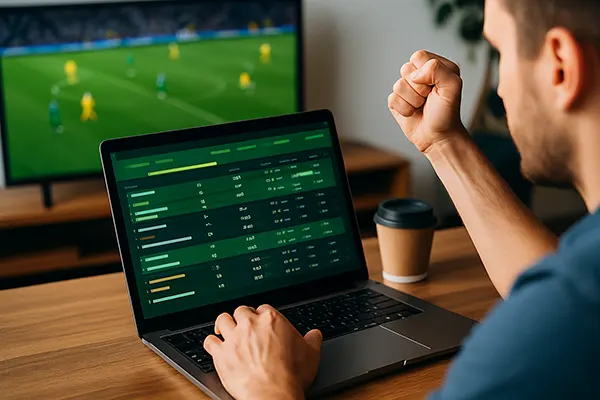Live Betting: When and How to Place Bets During a Match

Live betting has become one of the most dynamic areas of modern sports wagering. It allows fans to engage directly with the flow of the game, making decisions in real time based on team performance, momentum shifts and situational factors. To succeed in live betting, it is not enough to rely on intuition alone — careful analysis, timing and strategy play a decisive role.
Understanding the Nature of Live Betting
Live betting, often referred to as in-play betting, differs significantly from pre-match wagering. Odds shift constantly as the match unfolds, reflecting the latest developments and probabilities. This creates both opportunities and risks, as bettors can react instantly to what they see on the field.
One of the main advantages of live betting is flexibility. If your pre-match bet appears to be going in the wrong direction, you can hedge losses or adjust your strategy with a new wager. This adaptability makes it an attractive option for experienced bettors who are comfortable making quick, informed decisions.
However, the rapid pace of odds updates means there is little room for hesitation. Those who succeed in live betting typically combine strong knowledge of the sport with disciplined bankroll management, ensuring they do not chase losses in high-pressure situations.
Key Factors That Influence Live Betting Success
Several factors shape outcomes in live betting, including the current scoreline, player form, tactical changes and even external conditions like weather. A football team that concedes an early goal may become more aggressive, shifting the dynamics of the match and the betting market. Similarly, a tennis player struggling with unforced errors may be a weaker option for set betting.
Access to reliable live statistics is another cornerstone of success. Monitoring possession percentages, shots on target, fouls, or momentum shifts in basketball can provide insights beyond what is visible on the screen. Analytical thinking combined with up-to-date data helps identify valuable betting opportunities.
Lastly, emotional control cannot be underestimated. Many bettors fall into the trap of overreacting to dramatic moments, such as a red card or penalty. While these events matter, seasoned players evaluate the long-term impact rather than placing impulsive bets.
When to Place Bets During the Match
Timing is crucial in live betting. Some of the best opportunities emerge when the market overreacts to short-term events. For instance, odds may rise dramatically for a team that concedes early, even if they are historically strong at comebacks. Recognising these moments allows bettors to find value.
Another favourable window is during halftime. This break often brings stability to odds and allows bettors to reassess the situation without the pressure of constant gameplay. Many bookmakers also release special markets at this stage, offering unique angles for analysis.
Late-game scenarios can also present opportunities, especially in sports where endurance and mentality play a significant role. Teams leading narrowly may adopt defensive tactics, creating potential for markets like total goals or next team to score.
Common Mistakes to Avoid in Live Betting
One frequent mistake is chasing losses. Because live betting moves quickly, there is a temptation to “recover” with bigger stakes. This strategy often leads to poor decision-making and further losses. A disciplined approach is essential to long-term success.
Another error is overestimating one’s ability to predict outcomes based on emotions rather than analysis. Excitement from a favourite team’s momentum can cloud judgement, causing bettors to ignore the odds’ actual value. Rational decision-making is more effective than emotional attachment.
Finally, technical readiness matters. Slow internet connections, delays in data feeds or lack of familiarity with betting interfaces can result in missed opportunities. Ensuring your betting environment is optimised helps prevent costly mistakes.

Practical Strategies for Live Betting
Adopting specific strategies can enhance live betting performance. One widely used method is value betting, which involves identifying odds that underestimate the probability of an event. This requires quick analysis and the ability to compare bookmaker lines with personal assessment of the match.
Another approach is scalping, where bettors take advantage of small odds fluctuations by placing opposing bets on different outcomes at the right times. This requires fast reactions and a good grasp of market behaviour, but it can minimise risks if applied correctly.
Additionally, some bettors specialise in niche markets, such as corner kicks, free throws or player statistics. These markets may offer less liquidity but can provide significant advantages for those with detailed knowledge of specific sports dynamics.
Responsible Gambling in Live Betting
While live betting can be exciting, it carries higher risks due to its fast-paced nature. Setting strict budgets before engaging in any session is a vital safeguard against overspending. Bettors should always wager only what they can afford to lose.
Maintaining breaks and avoiding prolonged sessions is equally important. Extended periods of high-intensity decision-making can lead to fatigue and errors. Responsible players recognise when it is time to stop and return later with a clear mind.
Finally, using responsible gambling tools, such as deposit limits, time trackers and self-exclusion options, ensures that betting remains a form of entertainment rather than a harmful activity. These tools, widely available by 2025, help maintain balance and safety in live wagering.



